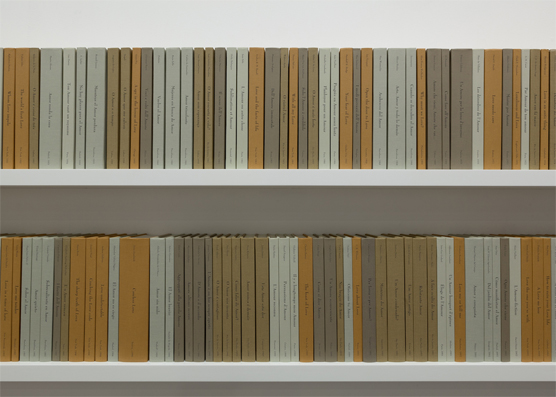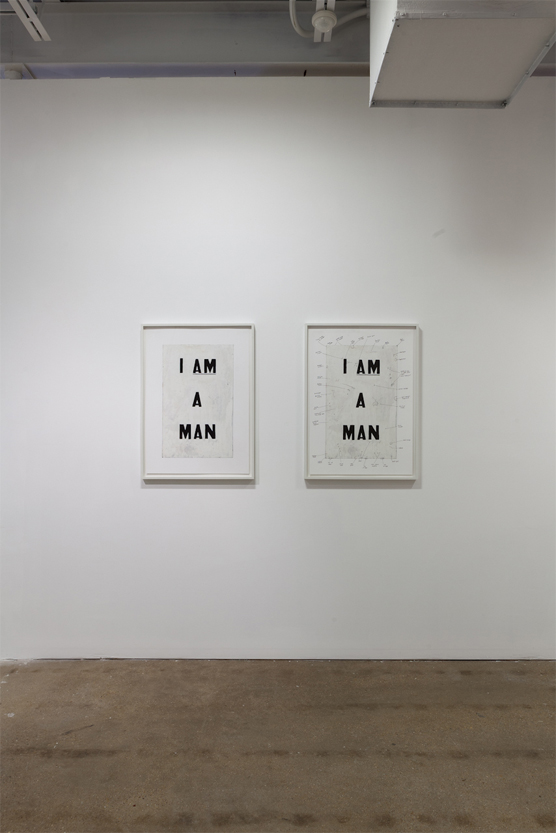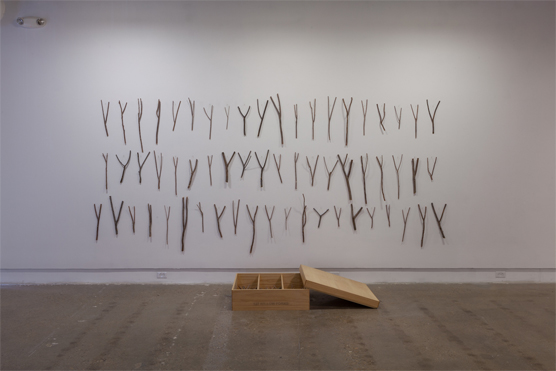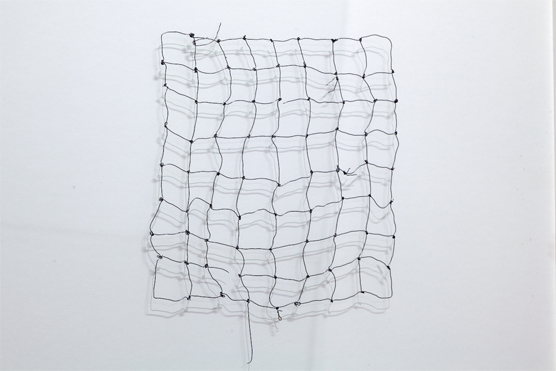One of the first things that strikes about the new exhibition, where is the power, at Fort Worth Contemporary Arts, is its title, a collection of lowercase words, whose subject – power – feels at odds with the diminutive, punctuation-less phrase. Like its title, the gallery installation is similarly understated; individual works function steadily in the space, without competing for attention. There is a cooperative equivalence at play—literally reinforced in a common muted palette—where each material or image does not command the theme with a capital letter or act as a final punctuation, marking the end of a thought or setting an overall tone. We are asked, instead, to reflect on power mostly through everyday items: books, chairs, walking canes, twigs, mirrors, and phones. And the familiar becomes revelatory. Doublings and multiples appear throughout, reminding that the origins of our public and personal dealings with power are fragmented and multifarious. Without a doubt, we navigate a world of multiple signifiers and multiple signifieds.
But before we get to the work in the gallery, there are a few aspects of the exhibition at play outside the space. In three different neighborhoods across Fort Worth, Kris Pierce has installed modified red payphones, one of which sits out near the street in front of Fort Worth Contemporary Arts. Each phone invites the public to make a vocal recording into a silent receiver. Subsequent confessions, statements, and even confusions will be woven into a single thread over the next two months. Intended to engage segregated communities in Fort Worth, the idea – and specifically the red telephone (think of the still active direct telephone line connecting the White House to the Moscow Kremlin) – is loaded with cultural meaning: urgency and an immediate need for dialogue. As Pierce combines and re-presents these voices, the exhibition extends further to the Internet, where recordings from each phone are already streaming (theredtelephone.net).

Also online, the reading “library” that Terri Thornton offers on the exhibition’s website, whereisthepower.com, is a much appreciated resource. While the list is full of lengthy, dense texts, it also points to more accessible articles like “A Short History of the Glass Mirror” by Josiah McElheny, a fascinating and essential component to understanding his work in the show. This online library is one of two in the exhibition, the other being Valeska Soares’ Love Stories II, a collection of books presented on two long white wooden shelves in the gallery. While the books are blank inside, they still contain page numbers and headers, and the page counts are true to the real editions of each book. Without an invitation to touch, we cannot handle these books or see inside their skeletal pages—flattening out the library into a tense sculptural list that occasionally softens into a love poem of chance. The piece points to a possible illusion of difference or choice: in the end, might it all be the same story about love?

The ways in which the pieces converse is where is the power’s greatest accomplishment. For instance, after wondering if Soares has presented us with copies of the same book, Chris Powell’s twin appears as an impossible single chair, Robert Kinmont’s twigs seem more literal and redundant, and Richard Wentworth’s canes collapse into a solitary cane and its shadow. And despite its distance in another room, Liam Gillick’s wall text momentarily echoes as one watches Zeide Isaac, Alejandro Cesarco’s profound video piece on witnessing, testifying, and the construction of memory and history.
In Glenn Ligon’s Condition Report, two prints become analogues of his 1988 painting that quotes the sign used by sanitation workers in Memphis twenty years prior. While this original meaning remains one of the most poignant assertions of humanity and citizenship in American history, and one could expand greatly on the historical richness, its position next to John Wilcox’s Tender also deserves attention. Where Condition Report doubles and divides, Tender contracts and binds. In unison, these paper surfaces conjure human bodies weathered and strengthened by experience, with “hairline cracks” and sensitive seams.

The body is referenced again by Kinmont’s compartmentalized box in 127 Willow Forks (This is Who I Am). Nearly half of the 127 branches hang gently on the wall, while the wooden container, set against the display, flips between being understood as receptacle and source. Perhaps Kinmont’s work implies a life of decisions, divergent paths that will each offer equal regret and benefit. Perhaps it is just the simplicity of a determined human collection of branching willow limbs. And given their presence in this exhibition acknowledging forced power, the limbs momentarily take the form of sling shots, even if the work feels too quiet and calm to remain weaponized for long.
Fred Sanback’s drawings bring to mind a kind of universal architecture and the responsibilities that come with the creation of space. We can assume the pair of drawings are proposals for thread installations, but as untitled renderings, each opens up to a floating, conceptual space, with the potential to transform any building. And like Sandback, many of the exhibited artists typically work on much larger scales, making the intimacy of works such as those by Cornelia Parker and Liam Gillick especially savory. Even Pierce’s city wide project that culminates on the Internet, offers privacy and solitude to participants, which will be interesting to see reversed as the exhibition progresses.
I left the opening night at FWCA thinking of the eager crowd of visitors, a room full of distracted and attentive witnesses, all wanting something from the work—or from each other. Just what does this work do without an audience such as the one that appeared in Fort Worth two Saturdays ago? Where is its power? Elmgreen and Dragset (of Prada Marfa fame) offer some relevant insight: “Art cannot be measured by its outcome. Its lack of direct effect is what makes it urgent in this world that is so focused on efficiency and results.” With this in mind, where is the power succeeds as a contemplative archive: starting points, testimonies, and outcomes that recall many aspects of the potential for power and its consequences. Each piece edits and punctuates Terri Thornton’s title differently with an invisible ink, leaving room for layered thinking and reflection.



Image at top: Still from Alejandro Cesarco, Zeide Isaac, 2009. 16MM film transferred to digital, edition of 5, 00:06:00 Courtesy of the artist and Murray Guy, New York. All photos by Kevin Tedora, courtesy of Fort Worth Contemporary Arts.




